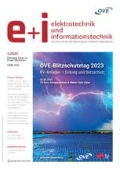Zusammenfassung
In den letzten Jahren hat der Umfang von Elektronik im Fahrzeug wesentlich zugenommen. Aktuelle Fahrzeuge stellen ein komplexes, verteiltes elektronisches System dar. Die große Anzahl an elektronischen Steuergeräten (ECUs) und die daraus erforderlichen Datentransfers benötigen eine hohe Bandbreite und verlässliche Kommunikationssysteme. Flexray beschreibt ein Kommunikationsprotokoll, das diese Anforderungen erfüllt. Aufgrund der höheren Datenrate und der konsequenten Bitlängenreduktion, die Flexray im Gegensatz zu den Vorgängern bietet, gibt es einschränkende Vorgaben. Eines der Hauptziele von Kommunikationsnetzwerkdesignern ist das Sicherstellen der Signalintegrität am Analogbus. Um Designprobleme vorherzusagen und Architekturentscheidungen zu unterstützen, arbeitet man mit Verhaltenssimulationen. Dieser Beitrag erklärt die Hauptgründe für die Analyse der elektrisch physikalischen Schicht (EPL), zählt die Vorteile von Verhaltenssimulationen auf und bietet eine detaillierte Übersicht über die Herausforderungen des Netzwerkdesigns und dessen Verifikation. Außerdem werden Auswirkungen unterschiedlicher Aspekte der Signalintegrität und folglich der Kommunikationsqualität und der Systemrobustheit anhand von geeigneten Anwendungsfällen, wie Topologieentscheidungen und Alterungserscheinungen, aufgezeigt.
Summary
In the last few years the amount of electronics inside cars has increased significantly. Current vehicles have implemented highly distributed electronic systems. The high number of Electronic Control Units (ECUs) and the high amount of data which must be exchanged require high bandwidth and reliable communication systems. Flexray is the communication protocol developed to fulfill these requirements. Due to its higher data rate and consequent bit length reduction, Flexray has more restrictive specifications than its precursor. One of the main goals of the communication network designers is on ensuring sufficient signal integrity at the analog bus. Behavioral simulations can be a useful tool for forecasting design problems and for supporting architecture decision. In this context, the paper explains the main reasons for analyzing the Electrical Physical Layer (EPL), lists the advantages of using behavioral simulations and provides a detailed overview of the challenges related to network design and verification. Moreover, it illustrates the impact of different aspects by way of dedicated use cases, such as topology decision and aging effects, on the signal integrity and therefore on communication quality and system robustness.
References
Armengaud, E., Steininger, A., Horauer, M. (2008): Towards a Systematic Test for Embedded Automotive Communication Systems. IEEE Transactions on Industrial Informatics, 4 (3): 146–155
Armengaud, E., Watzenig, D., Steger, C., Weiss, R., Netzberger, C., Kohl, M., Pistauer, M., Pfister, F., Gall, H. (2009): Combining the Advantages of Simulation and Prototyping for the Validation of Dependable Communication Architectures: the TEODACS Approach. In: SAE World Congress, Detroit, Michigan, USA
BOSCH – CAN Specification Version 2.0, Robert Bosch GmbH, 1991, [Online]. Available: http://www.bosch.com
Flexray Communications System Specifications, FlexRay Consortium, 2001, [Online]. Available: http://www.flexray.com
FlexRay Communication System Electrical Physical Layer Specification, FlexRay Consortium, 2001, [Online]. Available: http://www.flexray.com
Gerke, T., Bollati, D. (2008): An Automated Model-based Design Flow for the Design of Robust FlexRay Networks Thorsten Gerke. In: SAE World Congress, Detroit, Michigan, USA
Grisel, R., Wayzani, I., Mounier, P. (2009): System Simulation, VHDL-AMS Modeling in Automotive Context, the Example of a CAN Interface Circuit. In IECON’09, 35th Annual Conference of IEEE, Porto, Portugal
Hilger, U., Miropolsky, S., Frei, S. (2010): Modeling of Automotive Bus Transceivers and ESD Protection Circuits for Immunity Simulations of Extended Networks. In 9th International Symposium on EMC, EMC Europe 2010, Wroclaw, Poland
Karner, M., Krammer, M., Krug, S., Armengaud, E., Steger, C., Weiss, R. (2010): Heterogeneous Co-simulation Platform for the Efficient Analysis of FlexRay-based Automotive Distributed Embedded Systems. In: 8th IEEE International Workshop on Factory Communication Systems, Nancy, France
Kopetz, H., Bauer, G. (2003): The Time-Triggered Architecture. Proceedings of the IEEE, 91 (1): 112–126
Laude, D., (1994): IC Design Considerations for the Harsh Automotive Electrical Environment. In: Custom Integrated Circuits Conference, P. of IEEE International, pp. 319–326, San Diego, USA
Lawrenz, W., Bollati D. (2007): Validation of In-Vehicle Protocol Network Topologies, 2nd IEEE International Conference on Systems, ICONS’07
Mentor Graphics Open Source Model Library, [Online]. Available: http://www.mentor.com
Muller, C., Valle, M. (2010): System Verification of Flexray Communication Networks Through Behavioral Simulations. In: BMAS 2010, International Behavioral Modeling and Simulation Conference of IEEE, San Diego, California, USA
Muller, C., Valle, M., Buzas, R., Skoupy, A. (2009): Mixed-Mode Behavioral Model of Flexray Physical Layer Transceiver, Proceeding of the 19th IEEE European Conference on Circuit Theory and Design (ECCTD’09), Antalya, Turkey, 527–530
Muller, C., Valle, M., Prodanov, W., Buzas, R. A. (2010): Systematic Development Methodology for Mixed-mode Behavioral Models of In-vehicle Embedded Electronic Systems. EURASIP Journal on Embedded Systems
Prodanov, W., Valle, M., Buzas, R. (2009): A Controller Area Network Bus Transceiver Behavioral Model for Network Design and Simulation. Industrial Electronics, IEEE Transactions on, 56: 3762–3772
Prodanov, W., Valle, M., Buzas, R., Pierscinski, H. (2007): Behavioral Model of Basic Mixed-mode Circuits: Practical Issues and Application. In: Circuit Theory and Design, ECCTDŠ07, P. of IEEE International, vol. 1, pp. 854–857, Seville, Spain
Stangor, C. 2010: Research Methods for the Behavioral Sciences, 4th Ed., Wadsworth, Belmont, CA, USA
Shenkman, A. (1999): Circuit Analysis for Power Engineering Handbook, Springer, 1 st ed
VHDL Analog and Mixed-Signal Extensions, IEEE Std., Rev. IEEE Std 1076.1-2007, (2007)
Author information
Authors and Affiliations
Rights and permissions
About this article
Cite this article
Muller, C., Valle, M. Design and simulation of automotive communication networks: the challenges. Elektrotech. Inftech. 128, 228–233 (2011). https://doi.org/10.1007/s00502-011-0008-6
Received:
Accepted:
Issue Date:
DOI: https://doi.org/10.1007/s00502-011-0008-6

